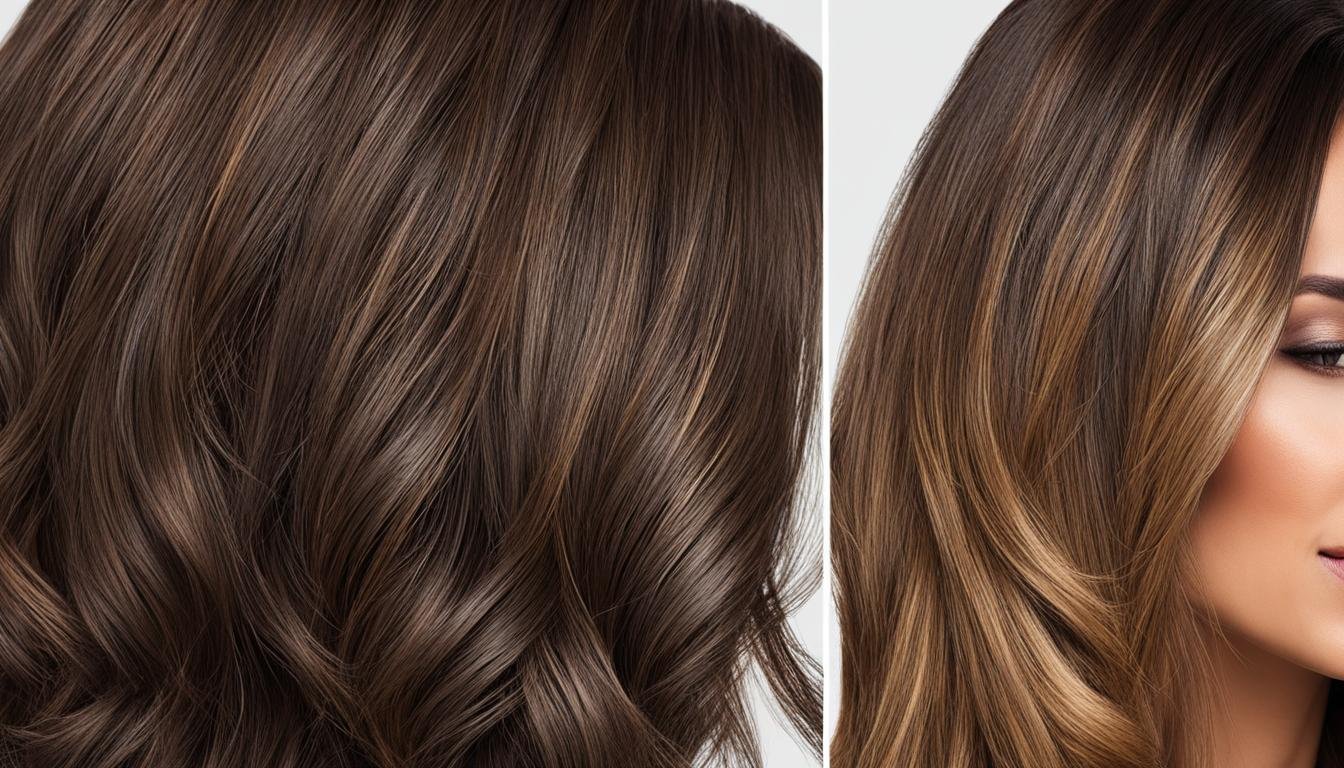Do you have lopsided tresses? Identifying the cause of irregular hair growth is the first step in correcting it. Hair that grows at varying rates in different sections of your head can make styling feel like an uphill battle. The four primary causes of uneven hair growth are genetics, stress, hair breakage, and whether you’re right or left-handed. Understanding these causes can help you find effective solutions to achieve hair balance.
Whether it’s a slight difference in length or noticeable asymmetry, it’s frustrating when your hair doesn’t cooperate. Finding the right fix for asymmetrical hair starts with determining the underlying cause. Sometimes, uneven hair growth can be traced back to your genetic makeup or hormone levels. Other times, it may be due to external factors like excessive heat styling or inadequate hair care.
When it comes to fixing asymmetrical hair, there are various approaches you can take. One option is to visit a professional hair stylist who specializes in dealing with asymmetrical hair. They can assess your hair’s current state and recommend suitable hairstyles or techniques to create the illusion of balance.
If you prefer a DIY approach, there are hairstyle ideas for asymmetrical hair that you can try. Experimenting with different cuts, layers, and lengths can help minimize the appearance of unevenness. Additionally, practicing proper hair care, such as regular trims and nourishing treatments, can promote healthier hair growth and reduce asymmetry.
It’s important to keep in mind that achieving perfectly symmetrical hair may not always be possible. Embracing your natural hair texture and working with a professional or experimenting with different styles can help you find a look that suits you and makes the most of your unique hair characteristics.
In the following sections, we’ll delve deeper into the causes of uneven hair growth, discuss the impact of hair type and care, explore hair growth cycles, share natural remedies and treatments, and advise you on when to consult a professional for targeted advice and treatment options.
Causes of Uneven Hair Growth
Uneven hair growth can be quite frustrating, but understanding the underlying causes can help you address the issue effectively. There are several factors that can contribute to uneven hair growth, including:
- Genetics: Your hairline genetics play a significant role in determining how your hair grows. Some individuals may naturally have hair that grows at different rates or in different directions.
- Hormonal imbalances: Hormonal changes in the body can disrupt the hair growth cycle and lead to uneven growth patterns. Common hormonal imbalances, such as those experienced during pregnancy or menopause, can affect hair growth.
- Medical conditions: Certain medical conditions, such as thyroid disorders or polycystic ovary syndrome (PCOS), can disrupt the normal hair growth cycle and cause uneven hair growth.
- Stress: Chronic stress can impact various bodily functions, including hair growth. Stress-induced hair shedding or breakage can result in uneven growth patterns.
- Hair breakage: Excessive heat styling, chemical treatments, or improper hair care practices can lead to hair breakage, resulting in uneven growth.
To better understand the causes of your uneven hair growth, it’s important to consider these factors and assess any potential underlying issues. Once you have identified the cause, you can explore suitable solutions to promote more balanced hair growth.
Taking Care of Your Hair
While you may not be able to change your hairline genetics or hormonal imbalances, there are steps you can take to optimize hair growth and minimize the appearance of unevenness:
“By following a healthy hair care routine and adopting protective styling practices, you can promote overall hair health and encourage more even growth.”
Comparison of Factors Affecting Hair Growth
| Factors | Effect on Hair Growth |
|---|---|
| Genetics | Affects hairline and overall growth pattern |
| Hormonal imbalances | Disrupts hair growth cycle |
| Medical conditions | Alters hair growth patterns |
| Stress | Leads to hair shedding or breakage |
| Hair breakage | Causes uneven growth due to damaged strands |
Impact of Hair Type and Care
Different hair types and textures can have varying rates of growth. Understanding your hair’s unique characteristics and implementing appropriate care practices can help promote healthy hair growth and minimize unevenness.
The Role of Hair Type
One of the key factors contributing to different hair growth rates is the individual’s hair type. Thick hair strands, for instance, may grow more slowly than fine hair strands. This is because thicker hair strands have a larger diameter and require more nutrients and energy to grow.
In addition, factors such as hair thickness and density can affect how noticeable uneven growth appears. Thicker hair strands may appear to have a more pronounced disparity in length compared to fine hair strands.
Regular Trims for Balance
Regular trims are essential for maintaining healthy and even hair growth. While it may seem counterintuitive to cut your hair when you’re trying to grow it out, trimming the ends regularly helps prevent split ends and breakage, which can impede growth and exacerbate unevenness.
By removing damaged and split ends through regular trims, you allow your hair to grow more evenly and prevent further breakage. Aim to schedule a trim every 8-12 weeks to maintain healthy hair and minimize the appearance of uneven growth.
Healthy Hair Care Practices
In addition to regular trims, adopting healthy hair care practices is crucial for promoting balanced growth. Avoid harsh chemical treatments, excessive heat styling, and overwashing, as these can damage the hair shaft and lead to uneven growth.
Instead, opt for gentle and nourishing hair care products suitable for your hair type. Use a wide-toothed comb or brush with soft bristles to prevent breakage and minimize tugging on the hair strands.
Furthermore, maintaining a balanced diet rich in essential nutrients, such as vitamins A, C, and E, biotin, and omega-3 fatty acids, can support overall hair health and encourage optimal growth.
“By taking care of your hair and understanding its unique characteristics, you can help balance out uneven hair growth.”
By prioritizing regular trims and healthy hair care practices, you can ensure that your hair remains in the best condition possible, minimizing the potential impact of uneven growth. Embrace your hair’s natural attributes, establish a consistent hair care routine, and enjoy the rewards of healthy, balanced growth.
| Hair Type | Growth Rate |
|---|---|
| Fine Hair | May experience faster growth due to its lightweight and thinner structure |
| Medium Hair | Typically grows at an average rate, neither too fast nor too slow |
| Thick Hair | May have a slower growth rate due to its thicker and denser structure |
| Curly Hair | May appear to have a slower growth rate due to the curl pattern and potential shrinkage |
Hair Growth Cycles and Phases
Understanding the different phases of hair growth is crucial for maintaining hair length and health. Hair growth occurs in cycles made up of three distinct phases: anagen, catagen, and telogen. Each phase plays a vital role in the overall growth and health of your hair.
Anagen Phase
The anagen phase is the active growth phase of the hair follicle. During this phase, the cells in the hair bulb divide rapidly, leading to the production of new cells that form the hair strand. The length of the anagen phase varies from person to person and can range from two to seven years.
Catagen Phase
Following the anagen phase, the catagen phase begins. This transitional phase lasts for about two weeks and is characterized by the shrinking of the hair follicle. The hair strand detaches from the blood supply and stops growing. It is during this phase that the hair follicle prepares for the next phase.
Telogen Phase
The telogen phase, also known as the resting phase, is the final stage of the hair growth cycle. During this phase, the hair strand is fully formed but not actively growing. The hair follicle remains dormant for approximately three months before entering a new anagen phase.
It’s important to note that different hair follicles on your scalp can be in different phases of the hair growth cycle at any given time. This is why some hairs may appear shorter or longer than others. Additionally, external factors such as stress, nutrition, and overall health can influence the duration and quality of each phase, impacting hair length and growth.
By understanding and supporting these natural hair growth cycles, you can work towards achieving a more balanced and even hair growth pattern. Adopting a healthy hair care routine, managing stress levels, and providing your body with the essential nutrients it needs can contribute to the overall health and length of your hair.
Natural Remedies and Treatments
When it comes to promoting healthy hair growth and achieving more balanced hair growth, there are several natural remedies and treatments that can be beneficial. These methods can help improve blood circulation, stimulate new hair growth, and provide nourishment to your hair.
One effective natural remedy is scalp massages. Massaging your scalp with gentle, circular motions can increase blood flow to the hair follicles, promoting the delivery of oxygen and nutrients essential for healthy hair growth. Additionally, scalp massages can help reduce stress, which is known to contribute to hair loss and disrupt hair growth cycles.
Another natural treatment option is rosemary oil. Rosemary oil has long been used for its potential to stimulate hair growth and improve hair thickness. By applying a few drops of rosemary oil to your scalp and massaging it in, you can harness its therapeutic properties and potentially promote more even hair growth.
Incorporating hair masks into your haircare routine is also a great way to provide deep conditioning and nourishment to your hair. Look for masks that contain natural ingredients like aloe vera, coconut oil, or argan oil, which can help restore moisture, strengthen the hair, and improve overall hair health.
Remember, maintaining a healthy diet is essential for hair growth. Your hair needs a variety of vitamins, minerals, and proteins to thrive. Ensure that your diet includes foods rich in biotin, vitamin E, iron, and omega-3 fatty acids, such as leafy greens, nuts, seeds, fish, and lean meats.
Lastly, consider incorporating protective styles into your hair routine. Protective styles like braids, twists, or updos can shield your hair from environmental damage and excessive manipulation, allowing your hair to grow without unnecessary strain or breakage.
By incorporating these natural remedies and treatments into your haircare routine and adopting a holistic approach to hair health, you can support more even hair growth and ensure that your locks are healthy and vibrant.
When to Consult a Professional
While there are various steps you can take on your own to address uneven hair growth, there may be situations where it is necessary to consult a professional.
If you notice severe hair asymmetry or if the difference in length cannot be attributed to your routine, it is recommended to seek advice from a hairstylist or medical professional. These experts can provide you with a professional hair consultation, assessing the underlying causes of your asymmetry.
By consulting a professional, you can receive targeted advice and treatment options specifically tailored to your individual hair needs. They can recommend suitable products, styling techniques, or even medical interventions to help you achieve a more balanced and symmetrical hair growth pattern.
Remember, seeking the expertise of a professional can offer valuable insights and expertise that may not be readily available through at-home remedies. Trusting a professional can ensure you receive the best possible solutions for your hair asymmetry, helping you to regain your confidence and enjoy a more even and harmonious hairstyle.

























